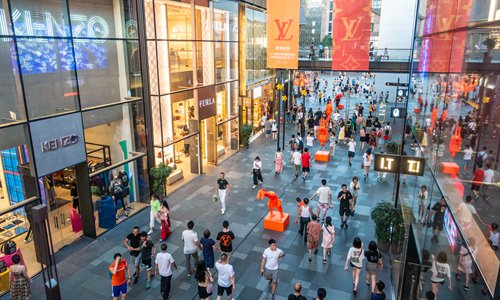
Chinese consumers walk in a shopping area in Chengdu, Southwest China's Sichuan Province. Photo: IC
China's consumer price index (CPI), a main gauge of inflation, rose 2.8 percent year-on-year in August, marking the sixth consecutive month that the CPI went above 2 percent. This was fueled in particular by the rise of pork prices due to African swine fever.
Observers predicted that China's CPI may break the 3-percent-inflation separation line in certain months of the fourth quarter as it will take some time for the pork supply to recover under the government's stimulative policy.
An elevated CIP driven by a single price gain is "controllable" and won't incur inflation risk. Beijing will continue to carry out its overall monetary and financial policy direction to boost liquidity in the market, they noted.
China's CPI reading is unchanged from July, but came in slightly higher than the market expectation of 2.7 percent. In July, China's CPI grew 2.8 percent, hitting a 17-month high, according to data released by the National Bureau of Statistics (NBS) on Tuesday. NBS said that the August CPI was "basically stable."
Surges in food prices have become key catalysts driving up the CPI.
In August, food prices rose 10 percent year-on-year, 0.9 percentage points higher than in July, which pushed CPI 1.93 percentage points higher. In particular, pork prices soared 46.7 percent in August year-on-year, accelerating 19.7 percentage points from July and contributing 1.08 percentage points to CPI hikes, NBS data showed.
Non-food prices grew 1.1 percent year-on-year in August, 0.2 percentage points lower than the July reading, lifting up CPI gains by 0.91 percentage points, according to NBS.
Tang Jianwei, the chief researcher at the Financial Research Center of the Bank of Communications, predicted that pork prices will continue to soar in the upcoming months due to an uptick in demands with the arrival of the Mid-Autumn Festival and the National Day holidays.
"It is highly likely that China's CPI will remain high in the fourth quarter. In certain months the reading could even pass over 3 percent, solely driven by pork price jumps," Tang told the Global Times on Tuesday. He also noted that China's CPI could stay in a relatively low range when taking out factors of pork prices.
China recently launched a batch of measures to ensure pork supplies and stabilize pork prices, such as releasing frozen pork into the market and providing subsidies to pig farmers. As it takes time to breed and raise hogs, industry insiders predict that it could take about half a year for the pork supply to rebound to a normal level.
Yang Yewei, an analyst at Southwest Securities, said that the market should not be overly concerned about an inflated CPI, which is due to pork supply shortages rather than demand expansion.
"This is is controllable and China won't experience an inflation risk this year," Wang Jun, a deputy director of the department of information at the China Center for International Economic Exchanges, told the Global Times on Tuesday.
The August CPI reading will not garner attention from policymakers, nor will it impede Beijing's macroeconomic policy direction, analysts said. Amid a boiling China-US trade war and rising global uncertainties, Chinese regulators should pay attention to "scaling up counter-cyclical policy support" to shore up China's economy and ease downward pressure, Tang said.
China's producer price index (PPI), a gauge of corporate profitability, declined 0.8 percent year-on-year in August, NBS data showed, pointing to a weakened demand at home. In July, China's PPI plunged 0.3 percent compared with a year ago.

